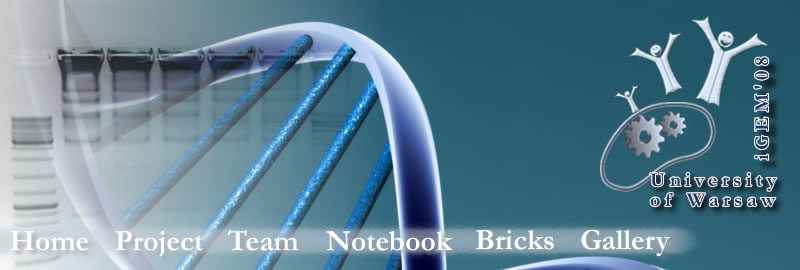Michał K.
- Gel electrophoresis (15 May PCR's) and DNA isolation from proper bands (600 bp for AID lane and 2700 bp for T7 polymerase lanes).
- Electrophoresis to estimate the concentration of isolated DNA.
- PCR - translational fusion: AID + T7 RNA-polymerase - optimization (annealing temperature gradient 60°C - 80°C). Fig. 1.
Primers:
AIDlNrH and
T7pXbSal
Template DNA: purified PCR products from 15 May - AID and T7 RNA-polymerase for translational fusion
Elongation time: 4 minutes
35 cycles
- Optimization of PCR - translational fusion: AID + T7 RNA-polymerase - MgCl2 concentration and number of cycles. Fig. 2.
Primers:
AIDlNrH and
T7pXbSal
Template DNA: purified PCR products from 15 May - AID and T7 RNA-polymerase for translational fusion
Annealing temperature: 73°C
Elongation time: 4 minutes
- Gel electrophoresis of PCR products.
 Fig. 1. PCR products - optimization of annealing temperature: 1-DNA ladder;
Fig. 1. PCR products - optimization of annealing temperature: 1-DNA ladder;
2 to 8 -annealing temperature 60°C (in lane 2) to 80°C (in lane 8).
 Fig. 2. PCR products - optimization of MgCl2 concentration and number of cycles:
Fig. 2. PCR products - optimization of MgCl2 concentration and number of cycles:
-
DNA ladder;
-
2 μl MgCl2, 20 cycles;
-
3 μl MgCl2, 20 cycles;
-
2 μl MgCl2, 25 cycles;
-
3 μl MgCl2, 25 cycles;
-
2 μl MgCl2, 30 cycles;
-
3 μl MgCl2, 30 cycles;
-
2 μl MgCl2, 35 cycles;
-
3 μl MgCl2, 35 cycles.
|
 |

 Fig. 1. PCR products - optimization of annealing temperature: 1-DNA ladder;
Fig. 1. PCR products - optimization of annealing temperature: 1-DNA ladder;  Fig. 2. PCR products - optimization of MgCl2 concentration and number of cycles:
Fig. 2. PCR products - optimization of MgCl2 concentration and number of cycles:  "
"





